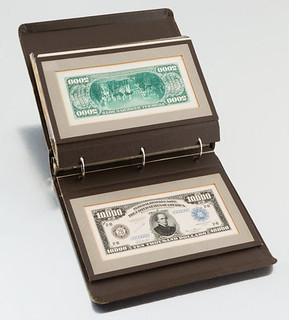
PREV ARTICLE
NEXT ARTICLE
FULL ISSUE
PREV FULL ISSUE
GRINNELL SERIES 1914 AND 1918 FRN PROOFSThere's an even more remarkable group of notes in the August Heritage sale. Also described in the July 16, 2020 Currency News email newsletter are the crowning gems of the legendary Albert Grinnell paper money collection, a binder of eighteen individual Proofs of Series 1914 and 1918 Federal Reserve notes of each denomination. Amazing! -Editor
On December 23, 1913, President Woodrow Wilson signed into law the Federal Reserve Act, which transformed the American monetary system. Throughout the next year, various prototype designs were produced and considered, until a standardized design was finalized in the fall of 1914. As a part of the design process, a small quantity of Proof examples was produced. These Proofs were printed from the actual currency plates onto card stock. The Treasury seal and the all zero serial numbers were glued on by hand by the pressman. Though the 1916 Annual Report of the Bureau of Engraving and Printing noted two sets of the $5 to $100 denominations produced, we know of additional (perhaps five) sets of Series 1914 Proofs that were presented by Secretary of the Treasury, William G. McAdoo, to a select group of officials in late 1914.

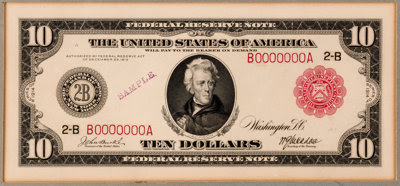
When the Federal Reserve became a better facility for banks to transfer large amounts of cash, the larger denominations were ideal. The Series 1918 Federal Reserve Notes were printed only in the $500, $1,000, $5,000, and $10,000 denominations. In the design process, Proofs were prepared for each of the denominations above. This is where the historical significance of this set ultimately lies. By 1926, the process for handling Proofs included rules for mandatory destruction of the items, preventing additional Proofs from being distributed outside the Bureau. While Specimen were still printed and distributed, these may be the last Proofs to have made their way out of the Bureau of Engraving and Printing, as none of the Series 1923 notes have appeared in any Proof form.
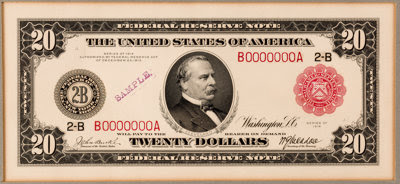
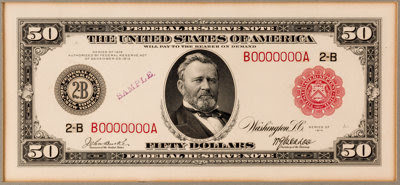
The binder with its eighteen individual Proofs, traces its history back to none other than Albert Grinnell, who acquired this phenomenal set of Proofs presumably from one of his friends and contacts within the Treasury Department. This set was the highlight of the entire seven-part Grinnell Collection sale conducted by Barney Bluestone. This grouping appeared in Part VI of the sale on June 29, 1946 as Lot 4871, and turned out to sell for a higher price than any of the other 5,897 lots in the entire seven-part sale. Since then, some of Grinnell's other notes have gone on to realize well into seven figures at auction in the last decade, including a Grand Watermelon, which currently tops the list of most expensive banknotes ever sold at auction, realizing $3,290,000 in our 2014 FUN Signature Auction. Bluestone took the opportunity to detail Mr. Grinnell's great pride in owning this set when he wrote in the catalog, "I can remember when Mr. Grinnell showed me his collection several years ago, that he reserved this lot of specimens, or engraver's impressions, until the very end. He felt that it was the crowning masterpiece of his successful achievement as a collector, and a fitting climax to his extensive and magnificent collection. He was respectably and justly proud of this possession and valued it highly." What Bluestone wrote next is as applicable today as it was in 1946: "Without doubt, this is a prize that will bring much joy to the heart of some collector. It is unique and, as stated previously, I do not believe its companion exists."

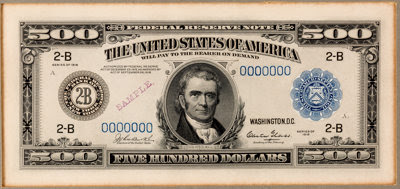
After selling for $4,050 in 1946, the grouping has made several public auction appearances, including Coins & Currency's August 7, 1969 sale, lot 1760; Forman & Taxay's December 6, 1974 sale, lot 250; New England Rare Coin Auction's March 26, 1976 sale, lot 9; NASCA's Brookdale Collection November 12, 1979 sale, lot 2230; and Stack's J.W. Thompson March 14, 1991 sale, lot 2136. The Notes All of the Proofs appear to be on both sides of the cardstock, although previous examples of similar notes have been uniface. The notes are printed on cardstock, and mounted in custom 6-1/2" x 9-1/2" frames that have been sealed on all four sides and fitted in a special leather binder that is believed to be contemporary to Grinnell. While these notes have not been graded, we believe that these notes will easily be seen as as-printed Gem New examples. The lower denomination notes ($5 through $100) are series 1914 Red Seal designs from the New York District. The black ink plate was used in each case to produce the base face impression with the red serial numbers and Treasury seal, and the black District seal and District number (2-B), all pasted in place. The serial number is B0000000A in each case. The engraved signatures are those of Burke and McAdoo. Both the face and back designs are the same as was used for production notes. All notes have SAMPLE stamped on the face.
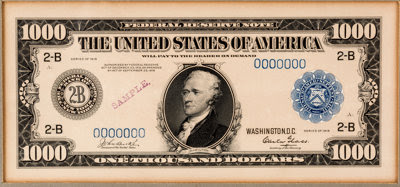

The higher denomination notes ($500 through $10,0000) are series 1918 Blue seal designs from the New York District. Again, the face Proofs were produced using the black ink plate to produce the basic face impression, with the blue Treasury seal, black District seal, black District number (2-B), and blue serial number (0000000) pasted in place. The engraved signatures are of Burke and Glass. All of the face and back designs are like those used for production. All notes have SPECIMEN stamped on the face. Examined in entirety, the notes are far better preserved than any of the other large size Federal Reserve Proofs in collector circles. Greater care seems to have been taken in the printing, cutting, and application of the seals and serial numbers, all of which have much bolder impressions and richer colors than the examples in other sets. While the aforementioned sets of $5 to $100 Red Seals presented by McAdoo are undeniably historically valuable and rare, it is the Blue Seal high denomination notes crowning this set that ensure that this is unquestionably the most important set of Proof notes in United States monetary history. The $500 and $1000 values are, of course, rare and difficult to acquire, but the $5000 and $10,000 are only collectable as part of this set. There are no examples of either denomination in private hands. The five examples of each outstanding denomination have been ensconced in either the Smithsonian or in one of the Federal Reserve Bank collections. The remarkable history, unique $5,000 and $10,000 impressions, and previous record setting prices realized, have established this set as one of America's most notable rarities in all of numismatics.
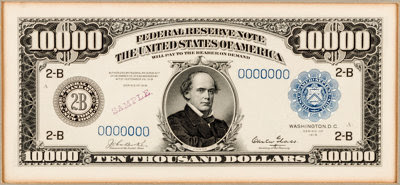

Wayne Homren, Editor The Numismatic Bibliomania Society is a non-profit organization promoting numismatic literature. See our web site at coinbooks.org. To submit items for publication in The E-Sylum, write to the Editor at this address: whomren@gmail.com To subscribe go to: https://my.binhost.com/lists/listinfo/esylum All Rights Reserved. NBS Home Page Contact the NBS webmaster 
|
